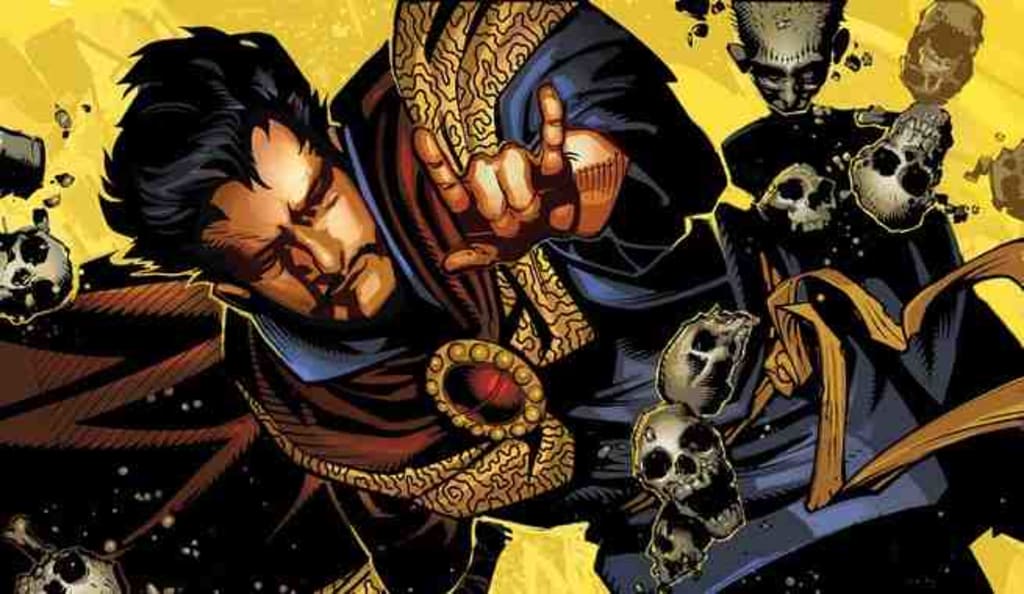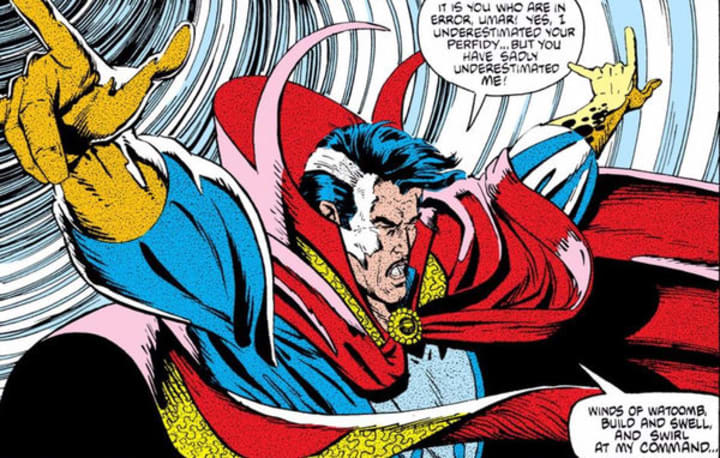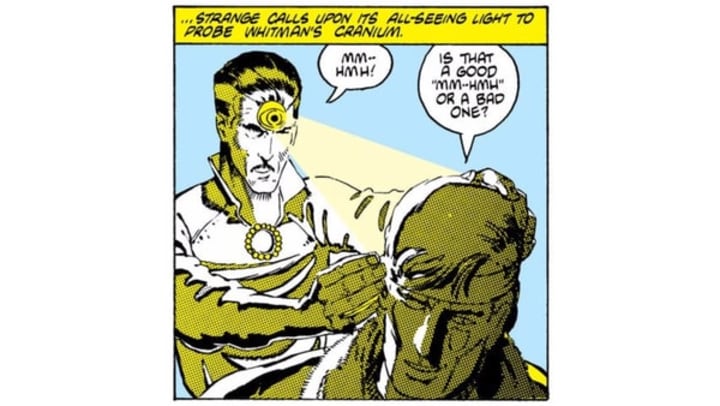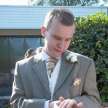
Right now, comic book fans are living in the very best of times. We're seeing all the superheroes we grew up with adapted for Hollywood. A decade ago, who believed that, in the space of a single year, we'd get to see Deadpool, Doomsday, Suicide Squad, Doctor Strange, and the launch of a new 'Phoenix Saga'?
But all of these films are inspired by comics, and it's worth taking a step back and asking — just how true to the comics is Doctor Strange?
Doctor Strange Himself

Strange things afoot! Image: Marvel Comics
Visually, Benedict Cumberbatch's Doctor Strange is almost perfect in terms of comic book accuracy. There's one beautiful scene where Strange rises, held aloft by the Cloak of Levitation, and as a comic book fan I almost cheered. In that second, the style of the film dovetailed perfectly with that of the comics.
In actual fact, the origin of the #MCU's Doctor Strange is almost pitch-perfect in terms of its comic book accuracy. The comics revealed Strange's origin in Strange Tales #115 (although he actually made his debut several issues earlier, in #110). We learned that Strange was a world-famous neurosurgeon who was badly injured in a car crash. Losing the use of his hands was a terrible blow for the proud and arrogant Stephen Strange, and he spent every penny he had trying to find a way to recover his skill. Ultimately, this brought him to the Ancient One, and there he learned the mystic arts.

The Ancient One's first appearance. Image: Marvel Comics
It's a famous origin tale, and it's been recounted many times. Doctor Strange follows that first half of the origin pretty much to the letter, with minimal changes. Different retellings of the story have always tapped into different arcs after that first act; Stan Lee and Jack Kirby's original tale had a brief conflict with Mordo, but Jason Aaron's Strange Origin miniseries presented a much more protracted, global conflict for Strange. It's no surprise that the film does its own thing after the basics of the origin, and that's hardly a problem.
The Night Nurse

Christine Palmer. Image: Marvel Comics
While Stephen Strange's personality and character are pretty much spot-on, the film takes a surprising number of liberties with the supporting cast. Rachel McAdams's Christine Palmer is a character who starred in the 1970s Night Nurse comics (another co-star is being used for Rosario Dawson's Claire Temple in #MarvelNetflix). In the comics, Christine is mostly forgotten, with one of her colleagues taking on the identity of Night Nurse (and working alongside Doctor Strange in The Oath).
Doctor Strange uses the character of Christine Palmer for two purposes; firstly, she adds a small element of humanity to its protagonist (she's an old love interest). Second she acts as a reminder that the world we're experiencing in Doctor Strange is pretty surreal. There's a beautiful scene lifted straight out of The Oath, where the comic book Night Nurse helped Strange out after he'd been shot with a bullet from Hitler's handgun (seriously). That's a very appropriate nod, given that The Oath introduced the idea of a romance between Linda Carter's Night Nurse and Doctor Strange, and the film seems to have happily lifted that concept too.
The Masters of the Mystic Arts

Tilda Swinton's Ancient One. Image: Marvel Studios
Cast your eyes to Kamar-Taj, though, and you see far more dramatic changes. Tilda Swinton's Ancient One was controversial back when her casting was first announced. With #Marvel facing cries of whitewashing, scriptwriter C. Robert Cargill explained that the comic book version of the Ancient One — a Tibetan mystic — would have threatened the Chinese release. Although Marvel denied this argument, the amount of Chinese product-placement in Doctor Strange — note Strange's (Chinese) Huawei Honor smartphone — suggests the company made a real effort to reach the Chinese market. Over in China, Honor is making the most of this, using Doctor Strange in TV ads:
"Both possess incredible superpowers."
Whatever your views on the casting of Tilda Swinton — which I've covered in detail elsewhere — you may be surprised to hear that one major plot twist is perhaps inspired by Strange Tales #115. At one point in that issue, the Ancient One is under attack from Mordo — and invokes a fascinating spell. Take a look:

Yes, you read that right; in Strange Tales #115, the Ancient One actually invokes "the spell of the Dread Dormammu"! It's really because Stan Lee was making up words and names as he went along, and had no idea who 'the Dread Dormammu' was back then — but I can't help finding it an ironic touch, given the major twist in Doctor Strange, where we learn the Ancient One is tapping into Dormammu's powers.
The other Masters of the Mystic Arts are reinvented as well. The idea of Benedict Wong playing his namesake as a manservant is ditched; the MCU Wong is a skilled warrior in his own right. What's more, the rivalry between Chiwetel Ejiofor's Mordo and Doctor Strange is ditched, with the film instead setting up a much more fascinating character arc that frankly improves on the comics. Mordo is definitely becoming an intriguing supervillain, but the end-credits scene sets him upon a path completely different to that of the comics. In the comics, Mordo sought power, and actually tapped into the Dark Dimension; in the film, Mordo comes to see sorcery as unnatural after learning that the Ancient One herself tapped into the Dark Dimension! The contrast at this point is remarkable, but in my view it actually improves on the original.

Mordo. Image: Marvel Studios
Where Doctor Strange is remarkably faithful in its depiction of Strange, it plays fast and loose with the rest of the cast. This seems to be for three reasons: firstly, with the world of Doctor Strange created back in 1963, it needed an update to improve diversity. As a result, female leads are added into the mix, and Mordo is race-swapped. Secondly, certain stereotyped roles are unsuitable for the present day — hence Wong is no mere manservant. But thirdly, whether we like it or not, politics does seem to have played a major role.
Into the Details
As I've discussed elsewhere, unlike the comics, the MCU has already presented a sort of 'science' of sorcery. This is largely because the film is introducing magic into a science-based world, and the filmmakers are smart enough to spot the potential deus ex machina. They limit the scale of the problem by establishing careful rules from the get-go, with sorcery actually being the art of tapping into the power of "other dimensions". The concept of "other dimensions" is actually used in two ways, both setting up other planes of existence — such as the wonderful Kirby-esque Dark Dimension — and the wider Marvel Multiverse.
The Eye of Agamotto is completely reworked for Doctor Strange. Back when the character was first created, Stan Lee didn't even bother to name it — he simply called it Strange's "amulet". Back in the day, the Eye pretty much did anything Stan Lee's plot needed it to do at the time, but since then, the comics have established rules for it. Nowadays, ownership of the Eye marks out the Sorcerer Supreme, and it provides insight and vision (even into the minds of men).

Strange uses the Eye. Image: Marvel Comics
In contrast, the MCU version of the Eye of Agamotto has been redesigned to fit into the MCU's overarching arc. It's an Infinity Stone — specifically, the Time Stone. This sets up a major role for Doctor Strange in Avengers: Infinity War, but also introduces the possibility that the inevitable Doctor Strange sequel will feature Strange no longer owning the Eye (depending on the outcome of Avengers: Infinity War). It's a dramatic redesign, but a smart one, ensuring this film has a place in the MCU's overall narrative.
Fascinatingly, some other details are perfectly aligned to the comics. I've discussed the Book of Cagliostro in an earlier post, but this minor detail is remarkably comic-book-accurate — second to Strange himself, it's the most comic-book-accurate detail in the film!
As you can see, Doctor Strange has a fascinating relationship to the original comics. It perfectly represents many details, and pays homage to countless others; but the film also plays fast and lose with many major characters and ideas, utterly redesigning them for the modern era and the context of the MCU. I'm sure this approach is set to divide comic book fans, but personally I can't help feeling that it works!
About the Creator
Tom Bacon
A prolific writer and film fan, Tom has a deep love of the superhero genre.






Comments
There are no comments for this story
Be the first to respond and start the conversation.